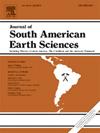Freshening processes in a prograding littoral system of the Río de la Plata–sea interaction area
IF 1.7
4区 地球科学
Q3 GEOSCIENCES, MULTIDISCIPLINARY
引用次数: 0
Abstract
The aim of this study is to evaluate groundwater freshening processes and the development of freshwater lenses in a littoral environment associated with the coastal progradation of beach ridges in the coastal area associated to the interaction zone of the Río de la Plata and the sea. To achieve this, a geomorphological analysis was conducted through the interpretation of satellite imagery, digital elevation models, and field observations, along with sediment sampling and texture analysis. Based on the geomorphology, transects were defined for conducting electrical resistivity tomography (ERT), and a monitoring network for groundwater and surface water was established. In situ measurements of pH and electrical conductivity (EC) were made, and water samples were collected for major ion determination. The geomorphological, sedimentological, geophysical, and hydrochemical studies have identified areas where freshening processes generate freshwater lenses in a littoral environment, initially dominated by saline water. These freshening processes are directly associated with the infiltration of rainwater under humid climate conditions and water surpluses. Infiltration primarily occurs in beach ridge deposits, which are positive landforms with high permeability. Spatially, it was observed that the formation of freshwater lenses mainly occurs in the more continental environments (older within the progradation of the beach ridges), where beach ridges exhibit greater topographic expression and are typically amalgamated deposits. In contrast, in the more coastal zones near the estuary, the development of freshwater lenses is limited by the lower topography of the deposits, which restricts rainwater infiltration and, consequently, reduces freshening processes. A similar situation occurs in the inter-ridge depressions towards the continental zone, where rainwater infiltration is present but limited, resulting in areas of freshwater-saline water mixing. This analysis of the distribution of freshwater lenses demonstrates spatial variation in freshening processes that is controlled not only by geomorphology (presence of beach ridges) but also by the evolutionary sequence of these landforms (progradation). The findings from this study are crucial for the development of sustainable water management and supply strategies in coastal regions, like the one studied, where freshwater resources are scarce.
Río de la Plata-sea相互作用区的一个推进的滨海系统中的净化过程
本研究的目的是评价与Río de la Plata与海的相互作用带有关的沿海地区的海滩脊的沿海推进有关的沿海环境中地下水的净化过程和淡水透镜的发展。为了实现这一目标,通过对卫星图像、数字高程模型、实地观测以及沉积物采样和纹理分析进行了地貌分析。基于地形特征,确定了样带进行电阻率层析成像(ERT),建立了地下水和地表水监测网络。现场测量pH值和电导率(EC),并收集水样进行主要离子测定。地貌学、沉积学、地球物理和水化学研究已经确定了一些地区,在这些地区,新生过程在最初以咸水为主的沿海环境中产生淡水透镜。这些新鲜过程与潮湿气候条件下雨水的渗透和水分过剩直接相关。入渗主要发生在滩脊沉积物中,这是一种高渗透性的正地貌。在空间上,观察到淡水透镜体的形成主要发生在更大陆的环境中(在滩脊的进积过程中更古老),那里的滩脊表现出更大的地形特征,通常是汞合矿床。相反,在靠近河口的较沿海地区,淡水透镜体的发育受到沉积物较低地形的限制,这限制了雨水的渗透,从而减少了新鲜过程。类似的情况也发生在向大陆带方向的脊间洼地,那里有雨水渗透,但有限,导致淡水和咸水混合的地区。对淡水透镜体分布的分析表明,淡水透镜体的空间变化不仅受地貌(海滩脊的存在)的控制,而且受这些地貌的演化顺序(进积)的控制。这项研究的结果对于在淡水资源匮乏的沿海地区制定可持续水资源管理和供应战略至关重要。
本文章由计算机程序翻译,如有差异,请以英文原文为准。
求助全文
约1分钟内获得全文
求助全文
来源期刊

Journal of South American Earth Sciences
地学-地球科学综合
CiteScore
3.70
自引率
22.20%
发文量
364
审稿时长
6-12 weeks
期刊介绍:
Papers must have a regional appeal and should present work of more than local significance. Research papers dealing with the regional geology of South American cratons and mobile belts, within the following research fields:
-Economic geology, metallogenesis and hydrocarbon genesis and reservoirs.
-Geophysics, geochemistry, volcanology, igneous and metamorphic petrology.
-Tectonics, neo- and seismotectonics and geodynamic modeling.
-Geomorphology, geological hazards, environmental geology, climate change in America and Antarctica, and soil research.
-Stratigraphy, sedimentology, structure and basin evolution.
-Paleontology, paleoecology, paleoclimatology and Quaternary geology.
New developments in already established regional projects and new initiatives dealing with the geology of the continent will be summarized and presented on a regular basis. Short notes, discussions, book reviews and conference and workshop reports will also be included when relevant.
 求助内容:
求助内容: 应助结果提醒方式:
应助结果提醒方式:


